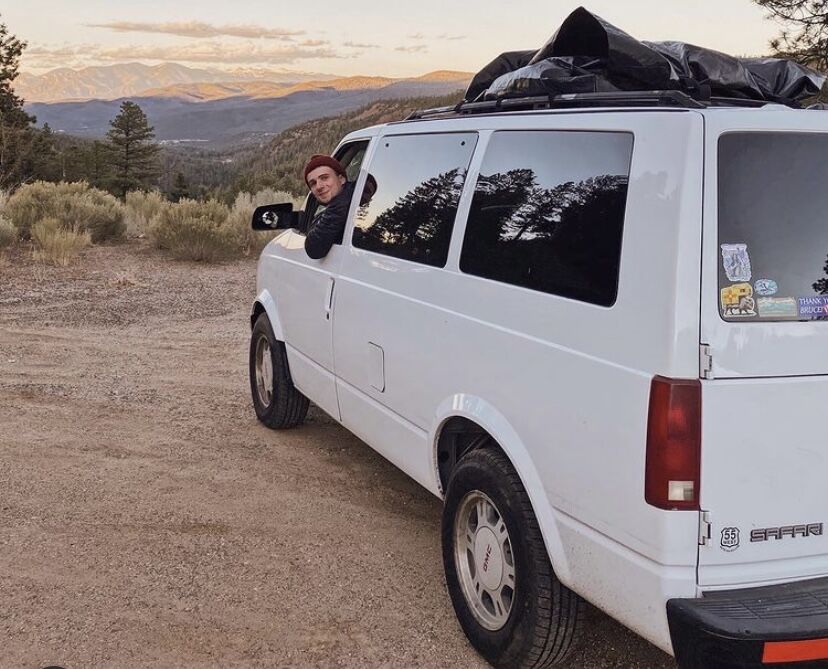What it’s like to renovate a van for car camping
March 3, 2021
Mary Mathis, a journalist living in New Mexico, travels in a van on weekends. Mathis and her partner, Cody Nelson, bought their van on Craigslist in October 2020.
They looked for inspiration on YouTube in order to renovate their van, but the renovations were done by carpenters that were able to spend around $5,000 on renovations. Mathis and Nelson ended up only spending about $400 on renovations. They built a bed frame and put in a mattress.
“You don’t need much more than that, and I think people get pretty extra when they’re living out of their van, but we’re not living out of the van,” Mathis said. “We use it for weekend rock climbing trips.”
Nelson and Mathis are both freelance reporters, so their schedules are flexible and allow for them to take trips in their van whenever they want. They typically only take weekend trips, but they hope to take a longer trip over the summer to San Diego or Tijuana, Mexico, to spend some time on the beach.
To begin a weekend trip, they grab breakfast from their favorite food truck, El Chile Toreado. After that, they get on the road and listen to music along the way. Upon their arrival, they begin rock climbing. Eventually, they stop and eat leftovers they packed. They typically open the back doors of the van, and they heat up their food on a camp stove. At night, they enjoy stargazing and making cocktails.
They disperse camp, which means they can park at any national forest or public land other than campsites. It costs money to park at a campsite, so they avoid this cost. They use an app called The Dyrt which helps them find dispersed camping spots to park overnight.
“New Mexico is the most undiscovered gem in the U.S.,” Mathis said. “There are endless places you can go.”
They have traveled all around New Mexico. Their favorite destination so far has been Truth or Consequences, a city in New Mexico known for its hot springs. While they were there, they visited a climbing park called Luna Park.
“It’s [about] 20 miles up into the mountains, so it’s pretty remote,” Mathis said.
They haven’t been able to take their van out as often as they wanted to due to the fact that their van does not have heat.
“It gets really cold in Santa Fe. That’s something that people are surprised to hear, but we’re at a really high elevation,” Mathis said. “If we take it up into the mountains, we’re at 8,000 to 9,000 feet and it’s really cold. So, without heat, it gets so cold in the van at night it doesn’t become this four seasons thing you can just take everywhere. You’re still camping, so if you wouldn’t be comfortable sleeping outside in 30-degree weather, you’re probably not going to sleep in a metal van that is really cold, too.”
Mathis warned of unforeseen costs that could come with a van.
“I think so many people romanticize getting a van and living out of it, and I do think it is really fun and it is really great and it gets you really close with nature, but you do have to remember that buying this vehicle and building it out is really expensive,” Mathis said. “And you’ll come into contact with expenses that you didn’t think you would have.”
Mathis and Nelson bought a beater van with little knowledge of cars and how to diagnose and repair issues. Mathis warns people looking to buy an older van to be wary of issues that will likely arise.
“My word of wisdom is: don’t buy an old van off of Craigslist,” Mathis said.
Mathis and Nelson have run into their fair share of issues with their van. On a trip to the Jemez Mountains, they stopped halfway up the mountain because they realized their van was leaking and smoking. A man informed them that it had been leaking for about two miles. They had to get their van towed, so they brought it to an autoshop and realized it had a lot of issues. There was a coolant leak and all of the shocks and support bars had to be replaced, along with more issues.
Despite the issues they have had, the van offers great opportunities they would not get without it.
“It’s just a really good way to try new things, though,” Mathis said. “We would never get to do two-day climbing trips if we couldn’t take the van all the way there and be comfortable staying overnight and have the same energy we need to go actually scale a rock the next day.”
Mathis encourages people to know their comfort level and what is best for them. Mathis and Nelson know they wouldn’t be able to live out of their van full-time, so they reserve it for short trips.
Mathis also points out that car camping in general is great. If there is a way for people to sleep comfortably in their car or to set up a tent outside of a car, that is a great way to get started doing this.
Mathis and Nelson are currently trying to sell their van and build out one of their cars they already have in order to take their trips in a more reliable vehicle.







